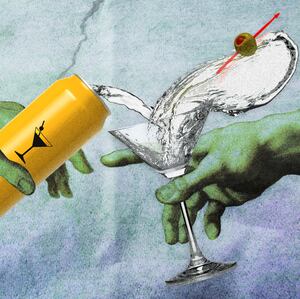The Walter family has farmed in the Midwest since the 19th century and since the 1930s they’ve been on a 2,000-acre farm 60 miles west of Chicago. They grow corn for the commodity market, mostly yellow dent, a starchy type of field corn that accounts for about 95 percent of all corn grown in the United States. It’s in demand for animal feed as well as to make ethanol and high-fructose corn syrup.
It’s also subject to unpredictable price swings, which makes turning a profit very tough—especially on a farm of just 2,000 acres. That may seem large if you live in a city, but the Walters have some neighbors working 30,000-acre farms. So in the early 2010s, Jim and Jaimie Walter, the father and son who own the farm, teamed up with Nick Nagele, a fifth-generation farmer turned seed marketer, to look at ways to find revenue streams not dependent on commodity corn.
Just as in the early 1800s when midwestern farmers converted grain to liquor to preserve excess crops and make them easier to ship to market, the Walters and Nagele decided to build a distillery. The trio called it Whiskey Acres and the facility opened in 2014, making bourbon and vodka with their yellow dent corn. Then they began to explore other crops that could feed their distillery and produce distinctive tasting spirits.
ADVERTISEMENT
Whiskey Acres now uses a variety of corn, including Glass Gem and Shaman Blue Popcorn, as well as a strain called Cock’s Prolific, a heritage varietal once grown by Thomas Jefferson. They’re also growing their own wheat, barley and rye to supply their stills. Rye, which they once grew only as a cover crop to add nutrients when tilled into the soil, is now used to make their bottled-in-bond rye whiskey, generating favorable notice and revenue.
The distillery can attract as many as 600 visitors over a weekend, many coming from Chicago to tour the farm distillery and buy bottles to take home. “We’re quickly coming to the point where the distillery will gross more than the farm,” Nagele says.
America’s agricultural system embraced centralization and factory farming starting in the 1970s, when U.S. agriculture secretary Earl Butz told farmers they needed to “get big or get out.” Since then, consolidation has continued unabated, with larger farms gobbling up smaller ones.
Even supply lines have been centralized. In 1988, 50.5 percent of corn seed in the U.S. was sold by the four largest biotech companies; by 2015, that had grown to 85 percent. The price of corn seed increased 259 percent between 1995 and 2011, while the promised boost in yield per acre rose only one-tenth that, according to the statistics from the National Agricultural Statistics Service as analyzed by the Center for American Progress.
The result is a farm system in which individual farms essentially become subcontractors to a multinational industry, which calls most of the shots. Farms that seek to break away from this system find a hard row to hoe. Federal policy and the trend toward factory farming essentially decrees that farmers should still get big or get out.
The alternative? Stay small but survive by selling directly to the consumer and adding value to crops whenever possible. Farmer’s markets have emerged as a lifeline for many small farmers— the number of farmer’s markets nationwide grew from 3,706 in 2004 to 8,140 by 2019, according to USDA’s Agricultural Marketing Service, and many reportedly served as a lifeline during the pandemic, as customers sought to avoid enclosed supermarkets.
Yet, sales from farmer’s markets account for a small portion of overall agricultural sales—$771 million sold direct to consumers in 2018, according to the Farmers Market Coalition, compared to $717 billion sold in grocery stores in 2019, according to the USDA’s Economic Research Service.
Another option for survival is to add value to the crop before letting it leave the farm. And so, like the Walters in Illinois, many farms have started looking at building distilleries, taking commodity grain and converting it to premium liquor.
Estate distilleries tend to arrive at their destination from one of two directions: farms that add distilleries, and distilleries that add farms.
Existing farms want to add value, such as Whiskey Acres, or JT Meleck, a Louisiana rice farm in the same family since 1896 that now makes whiskey. In Maine, there’s Cold River Vodka, that was launched in 2005 by a potato farming family looking for a better return on their crop.
There’s also Bently Heritage Estate in Nevada, a 2,500-acre ranch, which time had passed by. Christopher Bently grew up playing around the abandoned mill and creamery; when he inherited it years later, he turned it into a distillery, growing all the grain needed to make whiskey, gin and vodka. Among Bently’s crops are oats, wheat, rye, barley and corn, all of which end up in a bottle.
“I don’t think that consumers really understand what goes into making spirits,” says Bently distiller Johnny Jeffrey. “They understand the benefits of an estate winery, but I don’t think it’s translated to spirits, yet.” He notes that before Prohibition the country had upwards of 10,000 distilleries, most supporting local agriculture and producing liquor for local consumption. That’s been lost, but the local distillery using local grain is finding its way back.
Estate distilleries do everything on their own property, from grain to glass, or “from seed to spirit” as Whiskey Acres puts it.
But there’s another category of distillery, often based in cities rather than on farms, that’s still connecting with local growers and working with them to success. Call them “statement distilleries.”
Westland Distilling in Seattle doesn’t grow its own grain but is working with family farmers in the Skagit Valley, a little over an hour north of the distillery. They teamed up with Steve Jones and the Bread Lab, an organization Jones founded to work with area farmers to develop grains suitable for not only the region’s climate and soil, but also its economy—adding value by discovering grain varietals that grow well and make delicious breads, as well as barley varietals that do the same for beer and whiskey.
Westland marketing director Steve Hawley notes that they’re seeking grains that not only work for the farmer, but they’re using organic, “salmon-safe” methods that can reduce run-off harmful to fisheries. In its Outpost Range, Westland is exploring the region’s bounty—not only in best grains suited for the region, but also in wood used in barrels and local peat for smoked whiskey.
“New barleys that lead to new flavor profiles give the consumer new possibilities to explore in a whiskey landscape that has offered very little in the way of innovation for generations,” Hawley says.
Scott Blackwell at High Wire Distilling in South Carolina was a baker before discovering distilling (he founded Immaculate Baking, which he sold to General Mills in 2012). He connected early on with heritage grain expert Glenn Roberts, founder of Anson Mills, who steered him toward Jimmy Red Corn, a local varietal (named after James Island, near Charleston) that was said to be popular among bootleggers during Prohibition.
Jimmy Red Corn seed was scarce but working with Clemson University he arranged for plots to be grown to create more, and his dream of a whiskey made completely from it has since become his flagship project. He currently has 350 acres under cultivation, grown for him by five farmers.
Seeking the original provenance of the Jimmy Red Corn has brought Blackwell and his wife, Ann Marshall, to Mexico where he’s found a red corn variety called Tuxpeño, which he suspects is an ancient relation of the Jimmy Red corn that made its way to South Carolina. He exported 800 pounds of the Mexican corn—about enough for one barrel—which he distilled and is currently aging.
While whiskey distillers often have a nearly fetishistic relationship with their shiny stills, all agleam with copper, whiskey remains at root an agricultural product.
When made by estate and statement distilleries, a bottle of liquor is essentially a farmer’s market in a bottle. It allows one to taste the harvest of distant farms, while helping farmers keep doing what they’re doing in the face of the growing obstacles of the corporate agribusiness world. You can sip Skagit Valley or enjoy a tipple that started out in a faraway corn field high in the uplands of southern Mexico.
Seen another way, a bottle of whiskey is essentially a small greenhouse, housing an assortment of grains—corn, barley, wheat, rye. Of course, these grains are at the end of their life cycle rather than then the beginning, but whatever. Enjoy a glass and don’t take this notion away from me.







